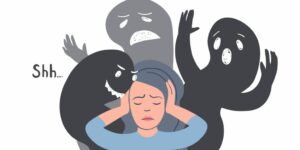Do you have a fear of harming others? If so, you may be suffering from harm OCD. This is a type of OCD that is characterized by intrusive thoughts about harming others. These thoughts can be extremely distressing and can lead to significant anxiety and distress. In this blog post, we will discuss what is harm OCD, how to treat them, and the symptoms associated with this condition.
Contents
What Is Harm OCD?
 Harm OCD is a subtype of OCD in which individuals are fixated on the fear of causing harm to themselves or others. This can manifest in a number of ways, such as constantly checking to make sure the oven is turned off. Or worrying that you will get into a car accident.
Harm OCD is a subtype of OCD in which individuals are fixated on the fear of causing harm to themselves or others. This can manifest in a number of ways, such as constantly checking to make sure the oven is turned off. Or worrying that you will get into a car accident.
People with Harm OCD often live in a state of constant anxiety and worry. Which can lead to significant distress and disruptions in their daily lives. This harm OCD is not the same as suicidal ideation, where individuals are actively considering harming themselves.
However, people with Harm OCD may engage in behaviors that unintentionally increase their risk of harm. For example, someone with Harm OCD may avoid driving because they are afraid they will get into an accident. However, this avoidance can lead to them becoming isolated and depressed. Moreover, people may view their intrusive thoughts as an indication that they are actually capable of harming others and this can lead to a great deal of guilt and shame.
What Are The Symptoms Of Harm OCD?
The symptoms of harm OCD can vary from person to person, but they typically center around a fear of causing harm to oneself or others. There are several kinds of symptoms that may be experienced:
- Intrusive thoughts or images about harming oneself or others
- Excessive checking or reassurance seeking behaviors aimed at preventing harm
- Avoidance of people, places, or activities that could potentially lead to harm
- Intense anxiety and distress when exposed to anything related to the fear of causing harm
These symptoms of harm OCD can cause a significant amount of impairment in daily functioning and quality of life. Moreover, some people may experience other related symptoms such as depression, anxiety, and substance abuse. In fact, the symptoms of this condition can be so severe that they lead some people to attempt or complete suicide. People need to be aware of the signs and symptoms of harm OCD so that they can seek treatment as soon as possible.
Although the symptoms of harm OCD can be very distressing, it is important to remember that they do not necessarily reflect what a person would actually do. People with harm OCD are usually highly aware that their thoughts and behaviors are irrational and excessive, but they feel powerless to control them. If you think you might have harm OCD, it is important to seek professional help.
Some Examples To Better Understand The Symptoms
 It is important to understand the symptoms of harm OCD in order to get the proper treatment. Here are some examples:
It is important to understand the symptoms of harm OCD in order to get the proper treatment. Here are some examples:
- For example, a person in the kitchen prepares food and cuts vegetables. Suddenly the knife in their hand seems very sharp and they have a strong urge to hurt themselves with it. They may start to shake or drop the knife altogether.
- A person might be driving and have an intrusive thought that they could crash into another car on purpose. They may start to feel like they have no control over the car and become extremely anxious.
- Another example can be a person who takes medication and starts to worry that they could overdose on their medication by mistake. They may start to feel like they can’t trust themselves with the medication and become very afraid.
These examples are very common in people with harm OCD. It is also important to understand that it is not a normal disorder or phase. If you or someone you know is experiencing these symptoms, it is important to seek professional help immediately.
What Causes Harm OCD?
The disorder is often dangerous and can lead to self-inflicted injuries, but the underlying causes are not currently known. There are many possible triggers for harm OCD, including:
- Traumatic event: Witnessing or experiencing a traumatic event can trigger harm OCD. This might include something like a car accident or a violent crime.
- Family history of OCD: If you have a parent or other close relative with OCD, you may be more likely to develop the disorder yourself.
- Stressful life events: Some people with harm OCD report that stressful life events (like starting a new job or going through a divorce) preceded the onset of their symptoms.
As it is being clear that the causes of harm OCD are not currently known, much more research is needed to understand this disorder. In the meantime, these causes can be really helpful in understanding your own risk factors and possible triggers.
If you have any of these risk factors, it does not mean that you will definitely develop harm OCD. But it is important to be aware of them so that you can seek help early if you do start to experience symptoms. However, the thoughts in this disorder are intrusive and can be very distressing. If you are struggling with these thoughts, please reach out to a mental health professional for help.
How To Treat Harm OCD?
 The treatment for harm OCD is very essential. Because it is a mental disorder, that requires help as soon as possible. As we all know, mental disorders are not something to be taken lightly. Here are some of the treatment options that you must give a try!
The treatment for harm OCD is very essential. Because it is a mental disorder, that requires help as soon as possible. As we all know, mental disorders are not something to be taken lightly. Here are some of the treatment options that you must give a try!
See a therapist
It is the prominent and most important treatment for harm OCD. You must see a therapist as soon as possible to get help. Therapists will help you understand your thoughts and feelings. And, they will also provide coping mechanisms to deal with the disorder. There are two types of therapy that are considered to be effective in treating harm OCD.
- Cognitive-behavioral therapy (CBT): It will help you to change the way you think. Also, teach you how to deal with your fears and anxiety. CBT is considered a great way to deal with harm OCD.
- Exposure and response prevention (ERP): In this therapy, you will be exposed to your fear triggers. But, you will be prevented from performing the compulsions. This therapy is considered to be very effective in treating harm OCD. ERP is often known as the gold standard for OCD treatment. It has been found 80% effective in treating OCD.
Try Mantra Care for harm OCD, Mantra Care is an effective and natural way to treat the condition. The website also offers a mobile app that uses the power of positive affirmations to help you overcome your fears and anxiety. You can book your free consultation today in order to learn more about how Mantra Care can help you.
Take medications
Another treatment option for harm OCD is medication. Medications can help to reduce the symptoms of OCD. However, it is important to note that medications should not be used as the sole treatment for OCD. Because medications are not a cure for OCD, they can help to reduce the symptoms.
There are two types of medications that are commonly used to treat OCD:
- Selective serotonin reuptake inhibitors (SSRIs)
- SSRIs are a type of antidepressant that can help to treat the symptoms of OCD.
- Serotonin and norepinephrine reuptake inhibitors (SNRIs)
SNRIs are another type of antidepressant that can also help to treat the symptoms of OCD. These medications work by increasing the levels of serotonin and norepinephrine in the brain. In fact, SNRIs are often considered to be more effective than SSRIs in treating OCD.
Support groups
Another treatment option for harm OCD is support groups. Support groups can provide you with a sense of community and understanding. They can also offer coping mechanisms to deal with the disorder. If you are interested in finding a support group, you can check out the International OCD Foundation website.
Harm OCD is a mental disorder that requires treatment as soon as possible. By getting help, you will be able to understand your thoughts and feelings. And, you will also learn how to deal with your fears and anxiety. There are many different treatment options available, so make sure to explore all of them!
Self-care techniques
 Self-care is an essential option for harm OCD. Because it helps you to cope with the symptoms of the disorder. There are many different self-care techniques that you can use. Here are some of them:
Self-care is an essential option for harm OCD. Because it helps you to cope with the symptoms of the disorder. There are many different self-care techniques that you can use. Here are some of them:
- Get enough sleep: Sleep is very important for our mental health. Make sure to get at least eight hours of sleep every night.
- Eat a healthy diet: Eating a healthy diet is essential for our mental health. Make sure to eat plenty of fruits, vegetables, and whole grains.
- Exercise regularly: Exercise is a great way to reduce stress and anxiety. It can also help to improve your mood and energy levels.
- Practice relaxation techniques: Relaxation techniques such as yoga, meditation, and deep breathing can help to reduce stress and anxiety.
- Journaling: It is a great way to express your thoughts and feelings.
Harm OCD can be a difficult disorder to deal with. But, by getting help and using self-care techniques, you will be able to cope with the symptoms. It is important to remember that you are not alone. There are many people who deal with this disorder. And, there is help available. So, don’t hesitate to reach out for it!
Moreover, if you know someone who is struggling with harm OCD, make sure to offer your support. Just being there for them can make a big difference.
Conclusion
To conclude, harm OCD is a subtype of OCD that is characterized by intrusive thoughts, and images. And urges related to harming oneself or others. Although it can be a very distressing and debilitating condition, there are effective treatments available. If you think you may have to harm OCD, please reach out to a mental health professional for help.
This condition is not your fault, and you are not alone. With proper treatment, you can live a happy and healthy life. Seek help today, and start living the life you deserve. Thanks for reading!
If you are looking for affordable Online OCD Counseling MantraCare can help: Book a trial OCD therapy session


